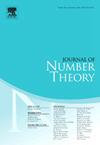有限域上拟裂偶特殊正交群的一个逆定理
IF 0.7
3区 数学
Q3 MATHEMATICS
引用次数: 0
摘要
证明了有限域上拟分裂非分裂偶特殊正交群的一个逆定理。有两个主要的困难产生于外部自同构和环面的非分裂部分。外部自同构的处理类似于分裂的情况,而新的想法被开发来克服环面的非分裂部分。本文章由计算机程序翻译,如有差异,请以英文原文为准。
A converse theorem for quasi-split even special orthogonal groups over finite fields
We prove a converse theorem for the case of quasi-split non-split even special orthogonal groups over finite fields. There are two main difficulties that arise from the outer automorphism and non-split part of the torus. The outer automorphism is handled similarly to the split case, while new ideas are developed to overcome the non-split part of the torus.
求助全文
通过发布文献求助,成功后即可免费获取论文全文。
去求助
来源期刊

Journal of Number Theory
数学-数学
CiteScore
1.30
自引率
14.30%
发文量
122
审稿时长
16 weeks
期刊介绍:
The Journal of Number Theory (JNT) features selected research articles that represent the broad spectrum of interest in contemporary number theory and allied areas. A valuable resource for mathematicians, the journal provides an international forum for the publication of original research in this field.
The Journal of Number Theory is encouraging submissions of quality, long articles where most or all of the technical details are included. The journal now considers and welcomes also papers in Computational Number Theory.
Starting in May 2019, JNT will have a new format with 3 sections:
JNT Prime targets (possibly very long with complete proofs) high impact papers. Articles published in this section will be granted 1 year promotional open access.
JNT General Section is for shorter papers. We particularly encourage submission from junior researchers. Every attempt will be made to expedite the review process for such submissions.
Computational JNT . This section aims to provide a forum to disseminate contributions which make significant use of computer calculations to derive novel number theoretic results. There will be an online repository where supplementary codes and data can be stored.
 求助内容:
求助内容: 应助结果提醒方式:
应助结果提醒方式:


